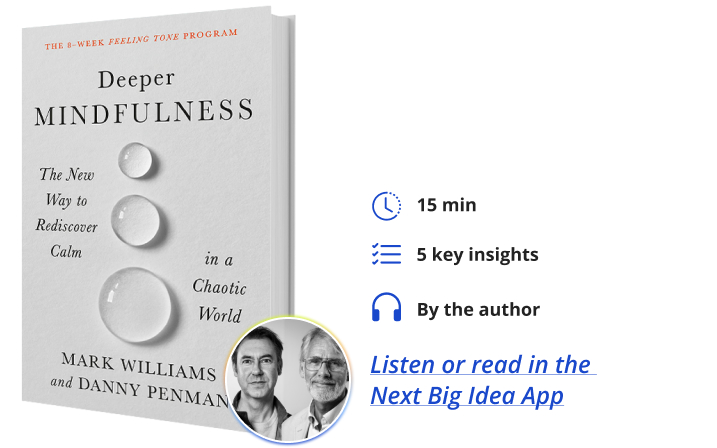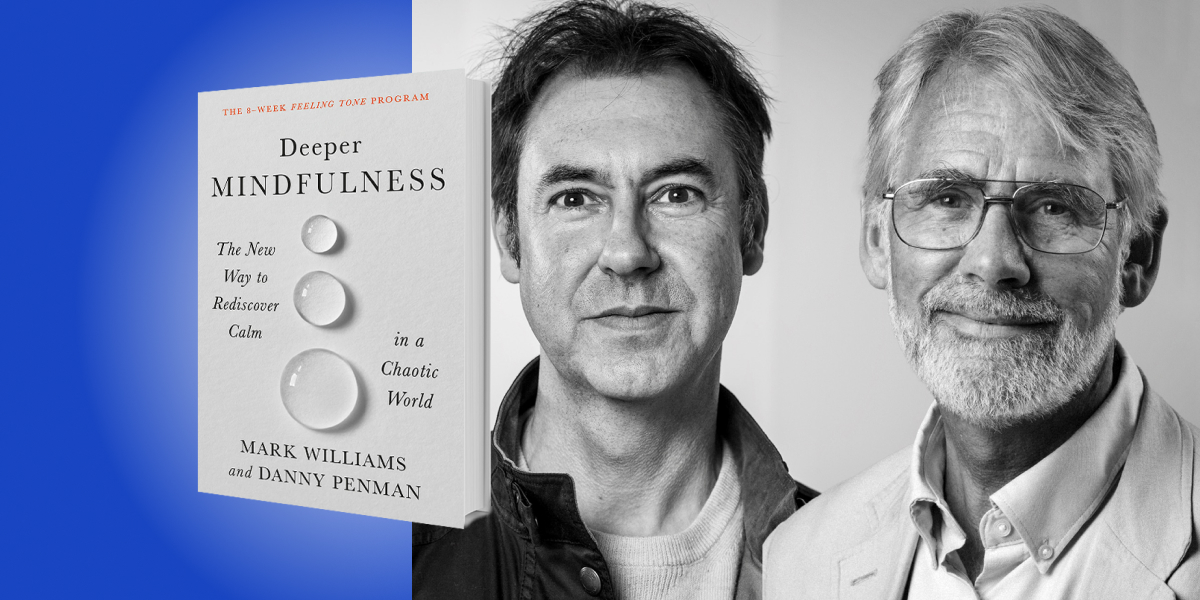Mark Williams is Emeritus Professor of Clinical Psychology at the University of Oxford. He has spent many years researching how mindfulness can combat cycles of depression. He is also a bestselling author and co-developer of Mindfulness-Based Cognitive Therapy (MBCT).
Dr. Danny Penman is a meditation teacher and the author of several books on mindfulness meditation, including the two-million-selling Mindfulness: Finding Peace in a Frantic World, co-written with Mark Williams.
Below, Mark and Danny share 5 key insights from their new book, Deeper Mindfulness: The New Way to Rediscover Calm in a Chaotic World. Listen to the audio version—read by Mark and Danny—in the Next Big Idea App.

1. We’re stuck inside a personal simulation of the “real” world.
Every morning, a man walked his four dogs in the park. Three of them always darted about, barking happily, tails wagging with delight. The fourth seemed happy enough but would only ever run around in tight little circles (albeit covering quite a distance), staying close to the man as he walked. Day after day, the parkkeeper watched the dog’s strange behavior. After a while, the keeper plucked up the courage to ask the man why his dog was behaving so oddly.
“Ah,” the man replied. “She’s a rescue dog. She was locked up for most of her life. That was the size of her cage.”
How often have you behaved like that dog? Free, but constantly running around in little mental circles. Free to be happy, yet caged by the same dark, repetitive thoughts. Free to be at peace with yourself and the world, while remaining trapped and entangled by anxiety, stress, unhappiness, and exhaustion.
Free as a dog in a cage.
So much of life is needlessly marred by little tragedies. Deep down, we know that we can live happy and fulfilling lives, and yet something stops us. Just as life seems to be within our grasp, it slips through our fingers.
“We do not truly see the world; we see what our minds think the world is about to look like.”
What we regard as the present moment is actually a stunningly realistic illusion created by the mind—an illusion so compelling that we mistake it for reality. This is called a simulation and it relies upon a process known as predictive processing. Predictive processing works by constantly “guessing” what information the senses are about to send to the brain. We do not truly see the world; we see what our minds think the world is about to look like. Nor do we truly hear, but instead experience the sounds that the mind believes are about to hit our ears. The same is true for other senses. The mind predicts what we are about to taste, feel, and smell. In practice, it is this prediction (or simulation) that we experience, rather than the “real” world.
This is a fantastically complex process, but a simple analogy helps: if you are talking about politics in the UK and someone mentions the Houses of P . . . you can guess what’s coming next (the word “Parliament”). Because you have predicted the word, you don’t need to listen to the word itself. You can instead use that moment to capture the meaning of the whole sentence. Such predictions make perception and responses more fluent because the world is normally predictable. We create predictions for all our senses simultaneously. We construct a global model that incorporates sights, sounds, smells, tastes, and sensations. This model is constantly updated and incorporates any deviations from the real external “reality”; we move through the world creating and updating—predicting and checking.
2. Mental distress can arise from an inaccurate simulation of the world.
The data from our senses is used predominantly to check the accuracy of the brain’s predictions. So, if you’re not paying attention, then these predictions can drift slowly away from “reality.” Much of our distress and mental ill-health can be seen as a simulation that is becoming increasingly less accurate.
We must be clear though, this idea of a simulation does not mean that if you feel anxious, stressed, depressed, or in pain you are in any way making up these feelings. You are truly feeling those things. What it means is that their origin and the mechanisms underpinning them are just different from what you may have believed.
3. An ancient practice can help your simulation regain its accuracy.
In the moment that the unconscious mind crystalizes into consciousness there is a very brief pause in which the mind senses—in a very simple way—whether something is pleasant, unpleasant, or neutral. It’s not a judgment. It’s an acknowledgment of how something feels. In Sanskrit and Pali, spoken in the lands of ancient India and Nepal, this feeling was known as vedana, often translated as Feeling Tone.
These moments are fleeting but they are often the most important ones in your life. This is because vedana is the tipping point in your mind that sets the tone for the sequence of thoughts, feelings, and emotions that follow. If it is pleasant, you will tend to feel positive, dynamic, and in control of your life. If it is unpleasant, you will likely feel slightly gloomy, deflated, and powerless. If it is neutral, then you will tend to feel bored and restless.
Feeling tones only ever come in these three flavors. It’s like a gut feeling. It’s not a matter of thinking hard about it, or searching for it, it’s more like the taste of something; you just know it when you taste it. Like tasting milk that’s gone sour, you know it’s unpleasant without having to think about it.
“Alternative futures are available.”
The trouble is that we humans have a special difficulty when it comes to vedana: our mental life is so complex that we can become lost inside of it. Our thoughts, memories, and plans also carry feeling tones, and these trigger ever more thoughts and emotions, which also carry feeling tones. The vedana can easily tip you into a vicious downward spiral that can ruin your whole day, and sometimes far, far longer.
Learning to sense the feeling tone teaches you to recognize your underlying state of mind and helps you make allowances for your sensitivities and entirely natural biases and reactions. It gives you space to respond rather than react. It helps you compassionately accept that although you might be anxious, stressed, angry, or depressed in this moment, this is not the totality of your life. You can change course. Alternative futures are available.
Tapping into an alternative future is as simple as sensing the underlying flow of feeling tones. This idea is common to many ancient traditions. And now, neuroscience agrees.
4. Mental health problems have their origins in the deepest reaches of our evolution.
Feeling tones rely on sensitivities built into every cell of our bodies from the earliest days of our evolution. Even single-celled creatures are sensitive to both nutrients and toxins. It allows them to distinguish between one and the other. This is the essence of vedana. It helps all living beings distinguish between the things that they should move towards (pleasant) and those that they should move away from (unpleasant) and encourages them to sit tight if everything is fine (neutral). Without such sensitivity, they would be like a boat without a rudder, with nothing to steer them away from danger and towards a friendly port.
In countless ways, vedana marks the difference between life and mere machinery. But our mental life is so complex that we can become lost inside of it. Our thoughts, memories, and plans can compel us to flee from our own minds.
And while we can flee, we can never escape.
This is the origin of much mental distress: the sense of being trapped within ourselves, destined to forever re-live our own distress, just like that dog in the story.
5. Meditating on feeling tones can relieve anxiety, stress, and depression.
Although vedana can make our lives very difficult, it can also be our salvation. Much mental distress can be gently relieved by learning to pay attention to our feeling tones in a special way.
Cognitive Behavior Therapy (CBT) and mindfulness-based therapies such as MBCT teach people how to “see” their thoughts, feelings, and emotions as if from the outside looking in. Negativity feels less personal. Distressing states of mind become seen as a stream of mental events. You can then learn to watch this sequence of mental events as if it were a stream flowing past you, with you watching with curiosity from the bank.
“It is possible to learn to pay attention to the moment-to-moment rise and fall of your feeling tones.”
In this way, such therapies enhance perspective and dissolve and dilute negative thoughts, feelings, and emotions—but they can only do this after they have first appeared in the mind and, crucially, begun to trigger other thoughts, feelings, and emotions.
But what if you could stop distressing states before they appear? What if you could go upstream to the moment just before they crystalized in your mind and gained momentum? Before the little stream of thoughts had turned into a raging torrent? If you could do this, then it would be far easier to “de-center” from your negative states of mind and your mental tangles would begin to unfurl, all by themselves.
It is possible to learn to pay attention to the moment-to-moment rise and fall of your feeling tones. It is possible to sense the moment just before your negative thoughts, feelings, and emotions appear. Before you slide into a vicious downward spiral.
Feeling tone meditations teach this skill. They are a way of recalibrating your simulation and the mental models it relies upon, of reconnecting with life at its most basic and profound level. Despite its ups and downs, the mind has the potential to be re-set to bring it ever closer to its natural state of quiet contentment.
To listen to the audio version read by co-authors Mark Williams and Danny Penman, download the Next Big Idea App today:






























